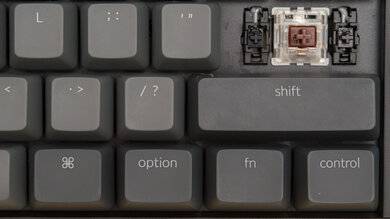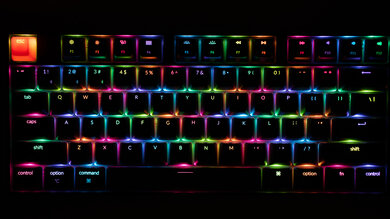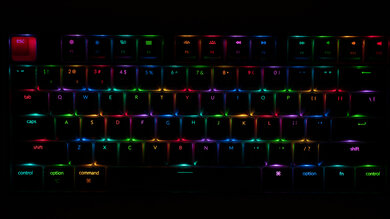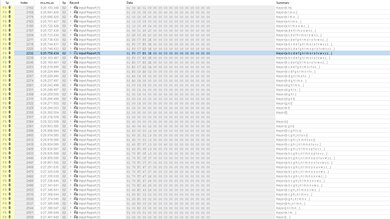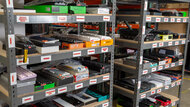The Keychron K10 is a full-size mechanical keyboard with Bluetooth support. Unlike most mechanical keyboards, it has a focus on productivity instead of gaming. It has multi-device pairing with up to three devices at once, so you can easily connect it to your PC, tablet, and phone. It features a switch for macOS and Windows compatibility, so all keys work on both operating systems as long as you're in the correct mode. It even comes with extra keycaps for each OS. It's available with clicky, linear, and tactile Gateron switches, and there's a hot-swappable variant. It has full RGB backlighting, and since it doesn't come with dedicated first-party software, you can't customize the RGB backlighting or reprogram any of the keys, but Keychron recommends third-party software.
Our Verdict
The Keychron K10 is decent for gaming. It has light-feeling tactile Gateron Brown switches, and it's available in clicky and linear too. It has full RGB backlighting if you game in a dark room environment. However, it lacks dedicated software, so you can't set macros or customize the backlighting. Its latency is also a bit too high for competitive gaming.
-
Gateron Brown switches are light to press.
-
Full RGB backlighting.
-
No dedicated software for macro or RGB customization.
-
Latency too high for competitive gamers.
The Keychron K10 is good for office use. It's well-built, and it comes with two incline settings, but it lacks a wrist rest. It's available with linear, clicky, and tactile mechanical switches, and the Gateron Brown switches on our unit provide a great typing quality. It can connect with up to three devices at once, and all keys work properly on both Windows and macOS.
-
Multi-device pairing with up to three devices.
-
Switch for Windows and macOS compatibility.
-
Great typing quality.
-
Wrist rest not included.
The Keychron K10 isn't bad for mobile use. It connects with any mobile operating system, and most keys work, except for a few function keys. It has multi-device pairing, meaning you can connect with up to three devices at once over Bluetooth. However, it's a full-size keyboard that's rather large, so it isn't ideal for carrying around.
-
Multi-device pairing with up to three devices.
-
Only a few function keys don't work on iPadOS, iOS, or Android.
-
Large size, hard to carry around.
-
Too heavy to use as a mobile keyboard.
The Keychron K10 is good for most programmers, but it's not ideal. Typing feels great because it has stable keys, and the Gateron Brown switches on our unit are light to press. It has full RGB backlighting, which is great for programming in a dark environment. Unfortunately, it doesn't have dedicated software, so you can't reprogram or set macros to any key, which may disappoint most programmers.
-
Full RGB backlighting.
-
Multi-device pairing with up to three devices.
-
Great typing quality.
-
No dedicated software for macro or RGB customization.
-
Wrist rest not included.
The Keychron K10 is okay for home theater PC use. It connects to any device via Bluetooth, and it has full RGB lighting, so you can see the keys easier in the dark. However, it's large, so it's not ideal for placing on your lap, and it doesn't have a trackpad.
-
Full RGB backlighting.
-
Multi-device pairing with up to three devices.
-
Large size, hard to carry around.
-
No trackpad.
- 7.0 Gaming
- 7.4 Office
- 6.7 Mobile/Tablet
- 7.7 Programming
- 5.9 Entertainment / HTPC
- 6.0 Raw Performance
Changelog
- Updated Nov 29, 2023: We've converted this review to Test Bench 1.3.1, which adds a new estimated PCB latency test to the Single-Key Latency section and a new Analog test to the Switches section of this review. You can see the full changelog here.
- Updated Oct 16, 2023: We've converted this review to Test Bench 1.3, which overhauls how key input is evaluated. We've added new tests for Single Key Latency, Multi Key Latency, Data Transmission, and Chord Split. We've also introduced a new Raw Performance usage and adjusted how the Gaming and Office usage scores are calculated. You can see the full changelog here.
- Updated Jun 12, 2023: We've converted this review to Test Bench 1.2. This update introduces new Backlight Features and Backlight Clarity test boxes. We've also added a new Switches test box, added additional test comparisons to our Hardware Customizability test box that we introduced with our last Test Bench. For an in-depth look at our changes, you can see our full changelog here.
- Updated May 02, 2023: After updating this keyboard onto our newest test bench, we've added text to the newHardware Customizability section of this review.
- Updated Apr 26, 2023: We've converted this review to Test Bench 1.1. This update adds several new tests addressing Hardware Customization, Macro Keys And Programming, and Wireless Mobile Compatibility. We've also added new objective evaluations to the Typing Noise test, and we've simplified several tests and removed several others that were no longer relevant. For an in-depth look at all our changes, you can see our full changelog here.
Check Price
Differences Between Sizes And Variants
We tested the Keychron K10 with an aluminum frame, RGB backlighting, and Gateron Brown switches. It's available in few different variants, with differences in backlighting and frame material. All the variants are available with the same switch type, and you can also get the hot-swappable version, meaning you can replace the switches with any compatible switch.
| Backlighting | Aluminum Frame | Gateron Switches |
|---|---|---|
| White | No | Red, Blue, Brown |
| RGB | No | Red, Blue, Brown |
| RGB with Aluminum Frame | Yes | Red, Blue, Brown |
If you have a variant of the K10 that doesn't correspond to our review, let us know in the discussions, and we'll update it. You can see our unit's label here.
Compared To Other Keyboards
The Keychron K10 is a good wireless mechanical keyboard. There aren't many mechanical keyboards with office use in mind, which makes this one stand out against other mechanical gaming keyboards, but that means it's not as versatile. Unless you only need a keyboard for office use and don't need to reprogram any keys, more customizable options are available.
Also see our recommendations for the best Keychron keyboards, the best keyboards for typing, and the best mechanical keyboards.
The Keychron Q6 and the Keychron K10 are both full-size keyboards with several prominent differences. The Q6 is a wired-only, customizable keyboard available either in a pre-built or barebones configuration and has a hot-swappable PCB and better overall build quality. It also includes robust customization software. On the other hand, the K10 is a wireless keyboard that supports multi-device pairing via Bluetooth. It has a hot-swappable variant available but has no customization software support.
The Keychron K10 and the Keychron C2 are similar mechanical office keyboards. The main difference is that the K10 is wireless with Bluetooth support, but the C2 is wired-only. The unit of the K10 we tested has RGB backlighting, and the C2 we tested has white backlighting, but they're each available in white and RGB variants. They're both available in the same types of switches, and typing is equally great on both.
The Keychron K2 (Version 2) and the Keychron K10 are similar keyboards in terms of features, but they're available in different sizes. The K10 is full-size with a standard layout, while the K2 is smaller at a 75% size, so it doesn't have a numpad or certain navigation buttons like Print Screen, Scroll Lock, and Pause Break. The K2 feels better built because the frame doesn't flex as much, but that's likely because the K10 is larger. They have many of the same features, and they're available with the same switch options.
The Keychron K6 and the Keychron K10 are similar in features and performance, but they're different sizes. The K6 is a compact 65% keyboard, while the K10 is full-size, so it has a function row, navigation keys, and a numpad. We tested each with Gateron Brown switches, and typing feels great on both. The K6 has slightly lower latency when used with the wired, but it's still not low enough for most gamers.
The Logitech MX Keys and the Keychron K10 are different types of office keyboards. Typing is great on both, but choosing one over the other depends if you prefer mechanical or non-mechanical keyboards. The K10 is mechanical and available with three types of mechanical switches, so you can get the ones you like, and it has full RGB backlighting. The Logitech is a non-mechanical option with scissor switches, and it has white backlighting. They each have Bluetooth support with up to three devices at once, but the Logitech also has a proprietary receiver. The Logitech has more customization options, too, as you can reprogram some function keys.
The Ducky Shine 7 is better for most uses than the Keychron K10. The Ducky has more gaming features, like macro-programmable keys and dedicated software to customize the RGB lighting, both of which the Keychron doesn't have. Typing also feels better on the Ducky, thanks to the PBT keycaps. However, the Keychron is better for mobile use because it has Bluetooth support, and you can connect with up to three devices at once.
The Keychron K10 and the Razer Pro Type Ultra are both full-size wireless office boards. If you want a board to match your white office setup, the Razer is a better choice. It has white backlighting, a wrist rest, and you can pair it with one more device thanks to its USB receiver. Also, all its keys are macro-programmable. It's available with linear Razer Yellow switches only, which may bother you if you prefer a different feel. On the other hand, if you prefer a dark-colored board with RGB backlighting, the Keychron is a better choice. Also, it offers more switch feels to choose from, including linear, tactile, and clicky Gateron switches.
Test Results
The Keychron K10 is a 100% keyboard. It's bigger than the 96% Keychron K4 because it has a few extra function keys, like Insert and Print Screen. It has a standard layout that isn't as cramped, either.
The Keychron K10's build quality is great. Our unit has an aluminum base plate, but you can also get the variant with a plastic plate instead. It feels solid, and the plastic chassis only shows some flex when you apply a lot of pressure on it. The ABS keycaps feel good, but they're not as solid as PBT, and they can feel slippery. The keys themselves feel stable and don't wobble too much while typing. The larger keys like the Spacebar, Enter, and Shift keys are very stable, and even though the Spacebar makes a different sound than the rest, it goes down evenly no matter which side you're pressing. There are rubber feet underneath to hold the keyboard in place, so it shouldn't move around during regular use. The incline feet are less grippy, but they still hold in place and shouldn't collapse if you move the keyboard. There's an upgraded series of these keyboards that have a better build quality and use PBT keycaps, called the Keychron K Pro Series.
The Keychron K10 is a basic straight keyboard with two incline settings. Even if you don't use the incline feet, it has a high profile. It doesn't feel too comfortable typing on it for long periods because of the height, and it would benefit from having a wrist rest. It doesn't come with one, but Keychron sells wooden wrist rests separately.
Note that the Keychron K10 we bought and tested isn't hot-swappable, but Keychron does offer a hot-swappable version of this keyboard compatible with standard 3- and 5-pin switches.
The included USB-C to USB-A cable is stiff and retains kinks from the packaging. It doesn't feel good, and it attaches on the left side instead of on the back like most keyboards.
The Keychron K10 can connect with up to three devices at once over Bluetooth. Keychron advertises that the rechargeable battery lasts up to 240 hours with the backlight off and around 70 hours with the backlight on.
There aren't many extra features on the Keychron K10. There are two switches on the left side. One is to change between the OS compatibility and the other changes between the connection type. It comes with specific keycaps for Windows and macOS, meaning you can match them to your PC's operating system. You can control the RGB lighting directly on the keyboard, but there's no dedicated software for customization, and you can't reprogram any key. There are media hotkeys too, which you can see here.
The Keychron K10 has great typing quality. Most keys are stable and don't rattle, and although there's some wobble to the alphanumeric keys, it's hard to notice. Even the larger keys like the Spacebar and Enter keys have good stabilizers. Speaking of the Spacebar, it has a more hollow sound than the other keys, and it rattles just a bit more, but it still feels good. The ABS keycaps feel soft and smooth, but that means they're also slippery once oil builds up on them. The Gateron Brown switches on our unit feel a bit mushy, so they're not as tactile as other switches; however, if you like tactile switches, you should still enjoy them. The pre-travel distance is on the long side, which isn't ideal for quick typing, but it also helps reduce the number of typos. It has standard key spacing, and your fingers shouldn't feel tired after long typing sessions, but your wrists may feel a bit of pain due to the lack of a wrist rest.
The Gateron Brown switches on our Keychron K10 are quiet and shouldn't bother others around you. However, the typing noise depends on the switches you get, and the Gateron Blue switches should be louder.
Our Keychron K10 has Gateron Brown switches, but you can also get it with clicky Gateron Blue and linear Gateron Red switches instead. Although these have a longer pre-travel distance than other tactile switches we've tested, they're light to press and offer decent tactile feedback. You'll know when you're about to actuate a key, which helps with reducing typos.
The Keychron K10 has decent latency. It's a bit too high for competitive gaming, but you shouldn't notice any delay while typing. If you want a mechanical office board to also play games with, the Razer Pro Type Ultra has much lower latency.
The Keychron K10 doesn't have dedicated software available for customization. Keychron recommends third-party software in the user manual, but we don't consider that as software.
The Keychron K10 has fantastic compatibility. Unlike most keyboards, all keys work on Windows and macOS as long as you set the compatibility switch on the left side to the proper OS. It even comes with extra keycaps for both operating systems. As for Linux, the Screen Brightness (F1 and F2) and the Fn + F3 functions don't do anything. The Voice Assistant key registers as C in the Windows mode and as Space in the macOS mode, but everything else works with either of the modes.
On iPadOS and iOS, you need to set the compatibility switch to macOS, and every key works except for F3 and F4, and the Voice Assistant key registers as Space. The Voice Assistant button on Android brings up the Contacts app, and the Windows key summons the voice assistant. The Fn + F4 works as an email shortcut.





